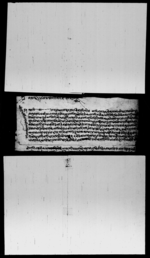A copy of a lālamohara granting Raṅganātha Pauḍyāla a house at Kathmandu’s Indracoka and further real property [VS 1861]
ID: K_0096_0012
Edited and
translated by Simon Cubelic
in collaboration with
Rajan Khatiwoda
Created: 2017-06-23;
Last modified: 2018-06-21
For the metadata of the document, click here
The accompanying edition, translation/synopsis and/or commentary are available under the terms of the Creative Commons Attribution-ShareAlike 4.0 International License
Abstract
This lālamohara records the grant of a house at Indracoka, Kathmandu, to Raṅganātha Pauḍyāla along with other real property—such as further houses, building land, fields and water mills—in other places of Nepal.Diplomatic edition
[1r]
1श्रीः\1९१1श्रीगुरुपंडितराजरंगनाथपंडित1आगे ¯ ¯ ¯ ¯ ¯ ¯ लाइसम्वत्१८६१सालचैत्रशुदि१रोजकादिनमाइन्द्रचौकमाकान्तीस्वरभयाकोघर2तसघरवाटचर्च्याकालगायातस्मेत्कुसपानिडल्लोलिसंकल्पगरिसर्वांकमारिमेटिविर्तावितलपगरीवक्स्यौ
3तस्कोसाध•पुर्वकास्मिरिकोघरवारिमषनटोलजान्यावाटोसिरोमनिअर्ज्याल्कोघरसालमीकोघरको
4वारकोघरदक्षिणसाल्मिकोघरनेवारकोघरभगवानकोघरलक्ष्मिधरउपाध्याकोघरपश्चिमनेवार
5कोघरवारिमुगलवाटोउत्तरदेव़व्राह्मणकोघरगंगापुत्रकोरहनुमल्लकोघररसतलकुसल्याको
6सतलघरयेतिचारकिलाभित्रमुलवाटोव़ारिपारिगरिज्माघरषा६१जवा३वारिषा६जवा२हात१२ये
7कपातालषा१४हात४॥रगामचागाउटुप्पाककाघर४मागलकोघट्ट१वोजमुडासमेतटुकुचापा
8रिकोघड्यारिवारीघरपथलिकोघघट्ट१वोडेकालगाकाघर७गोर्षाकाआमचौरभन्याकोगाउलगा
9यातसमेत्कांतिस्वरभयाकोघरविर्तावितलपभयाकोसर्वांकमारीमेटीलालमोहरगरीवक्स्यौं[?]
Translation
[1r]
Śrī
911
Venerable Guru Paṇḍitarāja Raṅganātha Paṇḍita
Āge: We have granted to --- (i.e., Venerable Guru Paṇḍitarāja Raṅganātha Paṇḍita) as a birtābitalapa exempted from all taxes the house at [the temple of] Kāntīśvara at Indracoka, including its curtilage, after kuśa and water were brought and a saṃkalpa was performed on a clod [from the plot] on ...day,2 the 1st day of the bright fortnight of Caitra in the [Vikrama] era year 1861. It has the [following] border demarcations: in the east, the plot (gharabārī) of a Kashmiri, the path to Makhana Ṭola, the house of Siromaṇi Arjyāl, the house on the near side of the house of a sālamī; in the south, the house of the sālamī, the house of a Newar, the house of Bhagavāna,3 the house of Lakṣmidhara Upādhyā; in the west, the plot of the Newar [and] the main path; in the north, the house of a devabrahmin,4 the house and the rest house (sattala) of Gaṅgāputra and Hanu Malla, the rest house [and] house of a kusalyā. In issuing [this] lālamohara, we grant the house at [the temple of] Kāntīśvara within these four boundaries—in total, a house [plot] [measuring] 61 khās and 3 javās on both sides of the main path, a homestead field (bārī) [measuring] 6 khās, 2 javās and 12 hātas, [and] a plot for [future] house [construction measuring] 14 khās and 4½ hātas, and additionally (lāgāyata) [we grant] 4 houses on the Gāmacā village heights, 1 water mill at Māgala, building land, a homestead field and a house on the further side of [where the?] Bojamuḍā5 [comes] together with the Ṭukucā [River], 1 water mill at Pathali, 7 houses in the Boḍe area and the village called Āmacaura in Gorkha—[all this] as a birtābitalapa exempted from all taxes.
Commentary
The present document does not specify who authorized the grant to Raṅganātha Paṇḍita who is commonly known as Raṅganātha Pauḍyāla (e.g. Pauḍela VS 2072). As it is the copy of a lālamohara, one can assume that it was issued by King Gīrvāṇayuddha Vikrama Śāha (r. 1799–1816). The document is dated 1805, only one year after Raṅganātha, who had entered upon service to Raṇabahādura in 1800 (cf. Whelpton 1991: 37), returned from his exile in Benares and became a rājaguru at the Nepalese court. The considerable amount of property transferred to Raṅganātha through this document reflects the influential position he had attained by that time.

